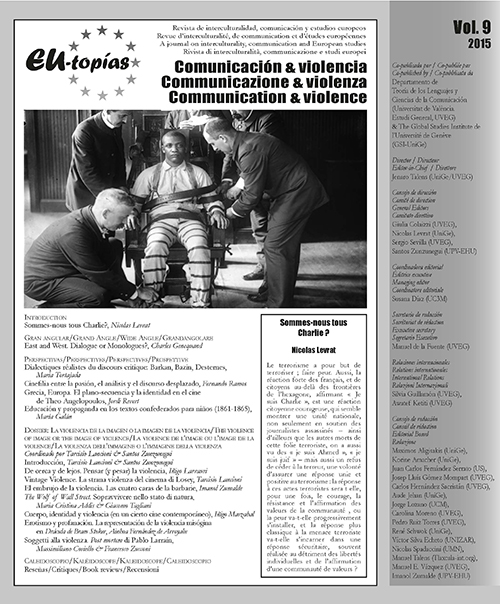Grecia, Europa. El plano-secuencia y la identidad en el cine de Theo Angelopoulos
DOI:
https://doi.org/10.7203/eutopias.0.18746Keywords:
Greece, Europe, shot sequence, crisis, History, identity, Theo Angelopoulos Abstract
Abstract
The latest fiction and non-fiction cinema has underlined the Greek crisis. Greece, formerly the cradle of European civilization, finds nowadays in cinema the portrait of a society in the midst of an economic downturn, having lost its identity. Nevertheless, this text looks to analyze beyond the socio-historical context in order to point to the structural aspects as a way to understand the eternal return to the trauma and the disaster. The tool used for that purpose is the shot-sequence in Theo Angelopoulos’ cinema. In the films of the Greek director, the shot-sequence works as narrative unity reelaborating time and space, and establishes a dialectic relationship with History and Greek identity. This dialogue works, at the same time, as previous step to the current thinking about Greece within a Europe gripped by the crisis.
 Downloads
Downloads
 References
References
Alberó, Pere (2012), «Theo Angelopoulos, una cronolo- gía», Cofre Theo Angelopoulos 1980-1986, Blog Intermedio, [http://intermediodvd.wordpress.com/2012/01/26/ theo-angelopoulos-una-cronologia-por-pere-albero- en-cofre-theo-angelopoulos-1980-1986] (consulta: 7 agosto 2014).
Aligisakis, Maximos (2013), «Les racines grecques de l’Europe», EU-topías, 6, pp. 75-84.
Bazin, André (1990), ¿Qué es el cine?, Madrid: Rialp. CompAny, Juan Miguel (1995), El aprendizaje del tiempo, Valencia: Ediciones Episteme.
Company, Juan Miguel & Ferrando García, Pablo (2013), «El tiempo suspendido», Aarón Rodríguez Serrano (coord.), Theo Angelopoulos. El paso suspendido: punto de encuentro, Santander: Shangrila, pp. 116-129.
Deleuze, Gilles (1987), La imagen-tiempo, Barcelona: Paidós.
Foucault, Michel (1999), El orden del discurso, Barcelona: Tusquets.
Gómez Tarín, Francisco Javier (2004), «Angelopulos y El viaje de los comediantes. Importancia perenne de la mise en abîme», Juan Domingo Vera Méndez & Alberto Sánchez Jordán (ed.), Cine y literatura: el teatro en el cine, Murcia: Universidad de Murcia.
Horton, Andrew (2001), El cine de Theo Angelopoulos, Madrid: Akal.
Jehan, Aude (2011), «Culture as a Key Factor Within Western Societies and a Political Tool for the European Union», Eu-topías, 1-2, pp. 85-93.
Lalanne, Jean-Marc & Kaganski, Serge (2010), «Jean- Luc Godard: “Europa existe desde hace mucho tiempo, no había necesidad de construirla como lo hemos hecho”», El Cultural, 3 de diciembre de 2010.
Micciché, Lino (2012), «El materialismo estético de Theo Angelopoulos», Caimán. Cuadernos de cine, 3 (54).
Morin, Edgar (1988), Pensar Europa, Barcelona: Gedisa. quintAnA, Ángel (2013), «Angelopoulos, el círculo, la historia y la utopía», Aarón Rodríguez Serrano (coord.), Theo Angelopoulos. El paso suspendido: punto de encuentro, Santander: Shangrila, pp. 26-33.
Sánchez, Faustino (2013), «Investigación, búsqueda y derrota: Angelopoulos en la frontera», Aarón Rodríguez Serrano (coord.), Theo Angelopoulos. El paso suspendido: punto de encuentro, Santander: Shangrila, pp. 10-25.
Steiner, George (2005), La idea de Europa, Madrid: Siruela. stevens, Brad (2012), «Split Decision», Sight & Sound, 22 (9), p. 79.
Vidal Estévez, Manuel (2009), Poemas de la desolación: el cine de Theo Angelopoulos, Huesca: Festival de cine de Huesca.
VV. AA. (1997), «Theo Angelopoulos», Nosferatu, 24.
Zumalde, Imanol (2013), «Liturgia materialista. La ideología estética del plano-secuencia de Angelopoulos», Aarón Rodríguez Serrano (coord.), Theo Angelopoulos. El paso suspendido: punto de encuentro, Santander: Shangrila, pp. 200-213.
Downloads
Published
How to Cite
-
Abstract466
-
PDF (Español)89
Issue
Section
License
![]()
The authors conserve the copyright. All content published in EU-topías. Journal of interculturality, Communication, and European Studies are subject to the license Creative Commons Attribution-NonCommercial-ShareAlike 4.0 license. The full text of the license can be found at <http://creativecommons.org/licenses/by-nc-sa/4.0>
They may be copied, used, disseminated, transmitted and publicly displayed, provided that:
- The authorship and original source of the publication is cited (journal, publisher and URL of the work).
- They are not used for commercial purposes.
- The existence and specifications of this license of use are mentioned.
It is the responsibility of the authors to obtain the necessary permissions for images that are subject to copyright.



